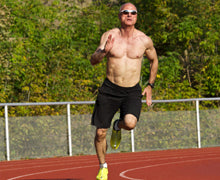
Sprinting and other forms of high-impact training are not something many people continue to do as they grow older but new data shows it could be beneficial in preventing skeletal aging. Researchers in Finland found older men who continued their sprint training maintained or even improved their bone health during a 10-year period compared to those who reduced their training load.
This study adds to the mounting evidence that shows the capability of high-intensity strength, spring and jumping training to decrease or prevent age-related bone loss. Researchers are hoping these results can be used to better understand why and how this type of training is beneficial.
"Part of the age-related bone loss is probably explained by reduced levels of physical activity,†says Tuuli Suominen from the University of Jyväskylä. “Especially intensive, bone-loading exercise typically decreases with age."
Researchers from the University of Jyväskylä’s Faculty of Sport and Health Sciences and Gerontology Research Center looked at the bone aging of a group of 69 men between the ages of 40 and 85. All men in the group were actively training and competing at the beginning of the study period.
The participants had their tibial bone properties examined by CT scan at baseline and again at the 10-year mark. The men were divided at the end by those who had continued with regular strength and sprint training and those who had reduced their training load.
Scientists found those who continued with their regular strength and sprint training maintained or even improved their tibial bone properties. At the same time, those who reduced their training saw their bone health decline over the 10-year follow-up period.
Researchers saw the positive effects were most evident in trabecular bone density and in the cross-sectional geometry of the tibial shaft. This was evidence of the benefits of both impact-type and strength training.
"Although the intensive training of the athletes as such is not possible for all aging people, strength and power training is highly recommended at all ages, regardless of the functional status," Suominen says. "In the present study, the benefits of high-impact training were most evident among middle-aged while strength training may be effective in preserving bone in older populations. Muscle strength and power are highly important also in preventing falls and related fractures."



